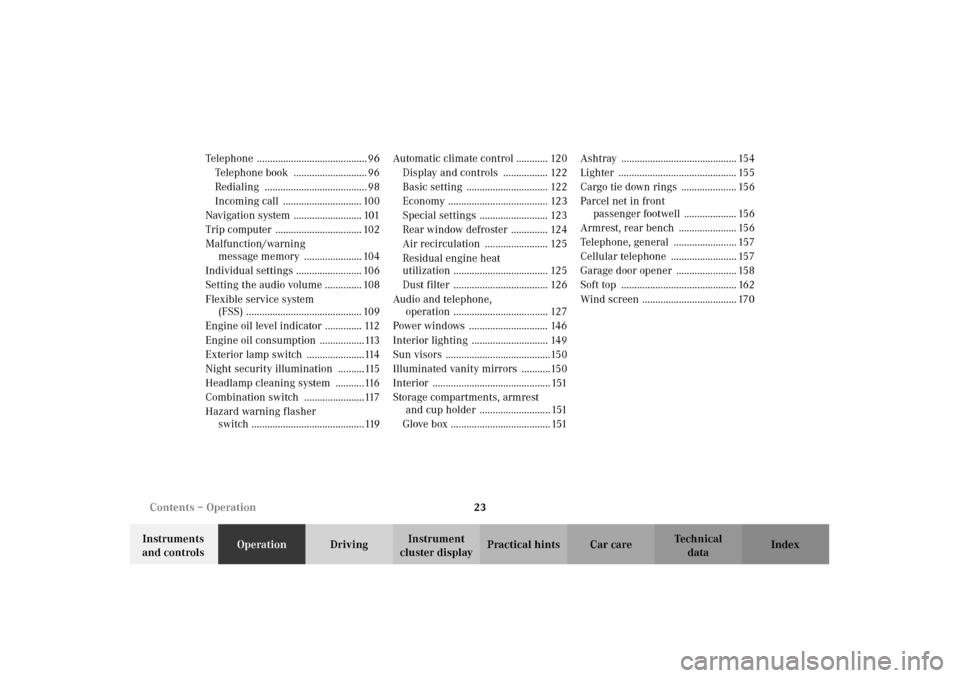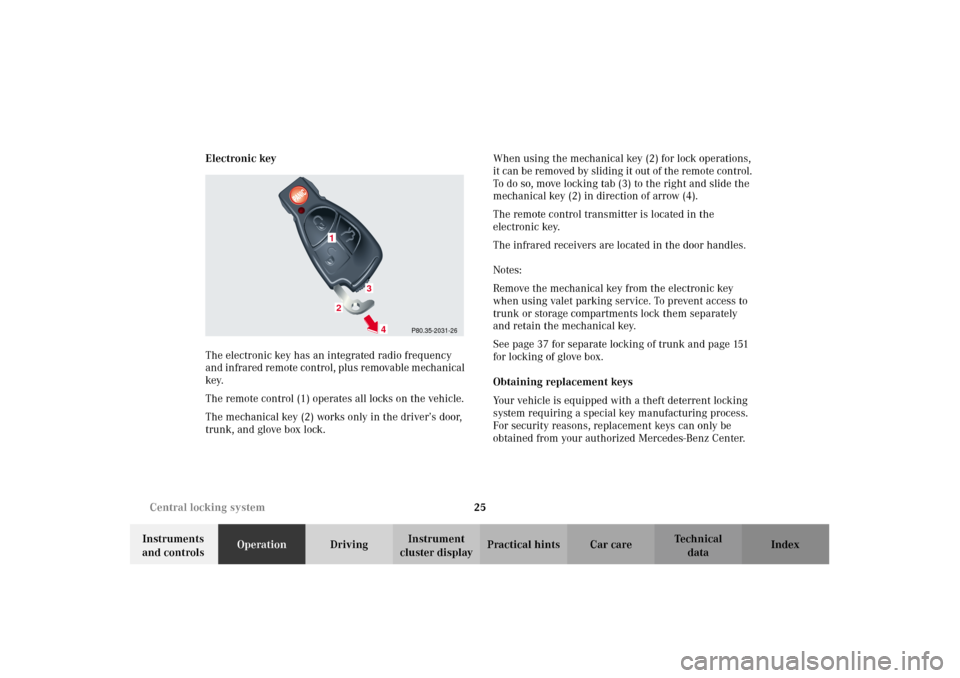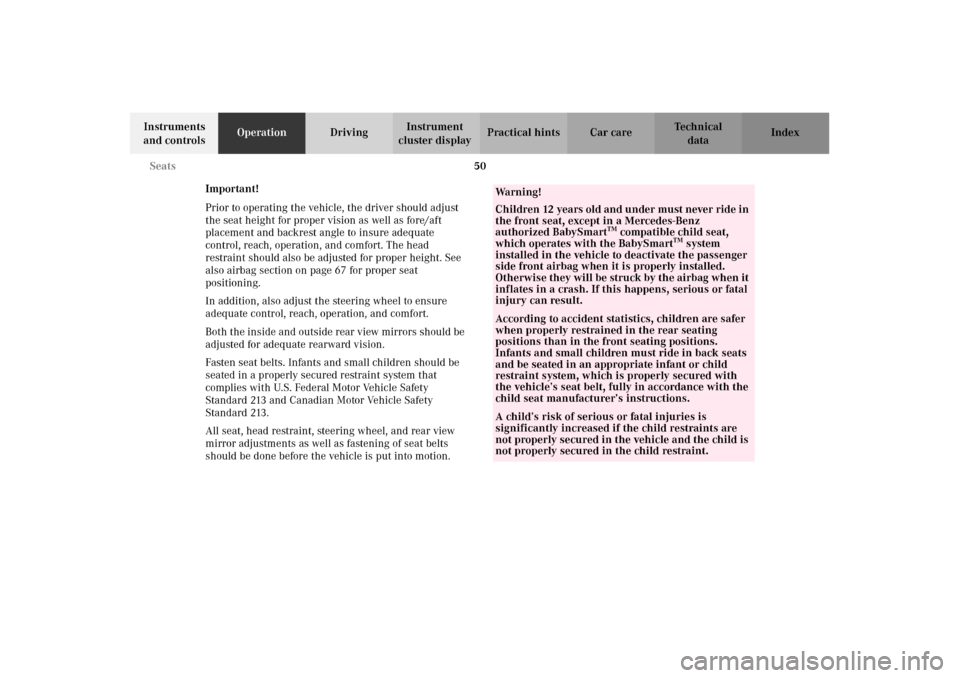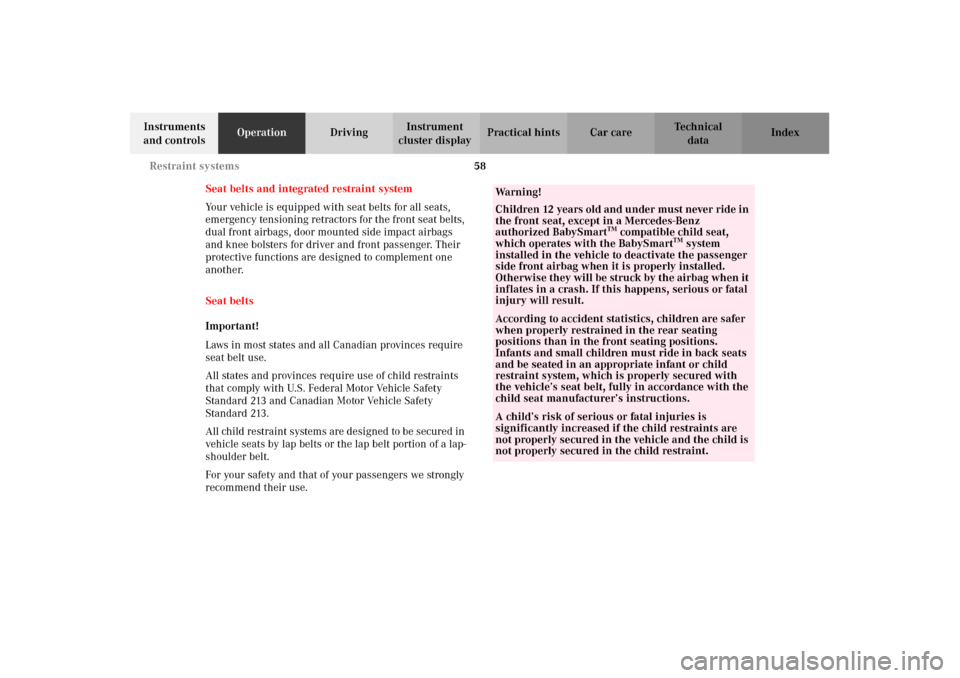2002 MERCEDES-BENZ CLK320 CABRIOLET ECU
[x] Cancel search: ECUPage 5 of 346

2 Contents
Multifunction steering wheel,
multifunction display ................. 88
Trip and main odometer
and sub menu .............................. 92
Audio systems .................................. 93
Radio .............................................. 93
CD player ....................................... 94
Cassette player ............................. 95
Telephone .......................................... 96
Telephone book ............................ 96
Redialing ....................................... 98
Incoming call .............................. 100
Navigation system .......................... 101
Trip computer ................................. 102
Malfunction/warning
message memory ...................... 104
Individual settings ......................... 106
Setting the audio volume .............. 108
Flexible service system
(FSS) ............................................ 109
Engine oil level indicator .............. 112
Engine oil consumption .................113
Exterior lamp switch ......................114
Night security illumination ..........115Headlamp cleaning system ........... 116
Combination switch ....................... 117
Hazard warning flasher
switch .......................................... 119
Automatic climate control ............ 120
Display and controls ................. 122
Basic setting ............................... 122
Economy ...................................... 123
Special settings .......................... 123
Rear window defroster .............. 124
Air recirculation ........................ 125
Residual engine heat
utilization .................................... 125
Dust filter .................................... 126
Audio and telephone,
operation .................................... 127
Power windows .............................. 146
Interior lighting ............................. 149
Sun visors ........................................150
Illuminated vanity mirrors ...........150
Interior ............................................. 151
Storage compartments, armrest
and cup holder ........................... 151
Glove box ...................................... 151Ashtray ............................................ 154
Lighter ............................................. 155
Cargo tie down rings ..................... 156
Parcel net in front
passenger footwell .................... 156
Armrest, rear bench ...................... 156
Telephone, general ........................ 157
Cellular telephone ......................... 157
Garage door opener ....................... 158
Soft top ............................................ 162
Wind screen .................................... 170
DrivingControl and operation of
radio transmitters ..................... 178
The first 1 000 miles
(1 500 km) ................................. 179
Maintenance ................................... 179
Catalytic converter ........................ 180
Emission control ............................ 181
Tele Aid ........................................... 182
Steering lock ................................... 192
Starting and turning off
the engine .................................. 194
J_A208.book Seite 2 Donnerstag, 31. Mai 2001 9:35 09
Page 26 of 346

23 Contents – Operation
Technical
data Instruments
and controlsOperationDrivingInstrument
cluster displayPractical hints Car care Index Telephone .......................................... 96
Telephone book ............................ 96
Redialing ....................................... 98
Incoming call .............................. 100
Navigation system .......................... 101
Trip computer ................................. 102
Malfunction/warning
message memory ...................... 104
Individual settings ......................... 106
Setting the audio volume .............. 108
Flexible service system
(FSS) ............................................ 109
Engine oil level indicator .............. 112
Engine oil consumption .................113
Exterior lamp switch ......................114
Night security illumination ..........115
Headlamp cleaning system ...........116
Combination switch .......................117
Hazard warning flasher
switch ...........................................119Automatic climate control ............ 120
Display and controls ................. 122
Basic setting ............................... 122
Economy ...................................... 123
Special settings .......................... 123
Rear window defroster .............. 124
Air recirculation ........................ 125
Residual engine heat
utilization .................................... 125
Dust filter .................................... 126
Audio and telephone,
operation .................................... 127
Power windows .............................. 146
Interior lighting ............................. 149
Sun visors ........................................150
Illuminated vanity mirrors ...........150
Interior ............................................. 151
Storage compartments, armrest
and cup holder ........................... 151
Glove box ...................................... 151Ashtray ............................................ 154
Lighter ............................................. 155
Cargo tie down rings ..................... 156
Parcel net in front
passenger footwell .................... 156
Armrest, rear bench ...................... 156
Telephone, general ........................ 157
Cellular telephone ......................... 157
Garage door opener ....................... 158
Soft top ............................................ 162
Wind screen .................................... 170
J_A208.book Seite 23 Donnerstag, 31. Mai 2001 9:35 09
Page 28 of 346

25 Central locking system
Technical
data Instruments
and controlsOperationDrivingInstrument
cluster displayPractical hints Car care Index Electronic key
The electronic key has an integrated radio frequency
and infrared remote control, plus removable mechanical
key.
The remote control (1) operates all locks on the vehicle.
The mechanical key (2) works only in the driver’s door,
trunk, and glove box lock.When using the mechanical key (2) for lock operations,
it can be removed by sliding it out of the remote control.
To do so, move locking tab (3) to the right and slide the
mechanical key (2) in direction of arrow (4).
The remote control transmitter is located in the
electronic key.
The infrared receivers are located in the door handles.
Notes:
Remove the mechanical key from the electronic key
when using valet parking service. To prevent access to
trunk or storage compartments lock them separately
and retain the mechanical key.
See page 37 for separate locking of trunk and page 151
for locking of glove box.
Obtaining replacement keys
Your vehicle is equipped with a theft deterrent locking
system requiring a special key manufacturing process.
For security reasons, replacement keys can only be
obtained from your authorized Mercedes-Benz Center.
P80.35-2031-26
1
3
4
2
J_A208.book Seite 25 Donnerstag, 31. Mai 2001 9:35 09
Page 53 of 346

50 Seats
Technical
data Instruments
and controlsOperationDrivingInstrument
cluster displayPractical hints Car care Index
Important!
Prior to operating the vehicle, the driver should adjust
the seat height for proper vision as well as fore/aft
placement and backrest angle to insure adequate
control, reach, operation, and comfort. The head
restraint should also be adjusted for proper height. See
also airbag section on page 67 for proper seat
positioning.
In addition, also adjust the steering wheel to ensure
adequate control, reach, operation, and comfort.
Both the inside and outside rear view mirrors should be
adjusted for adequate rearward vision.
Fasten seat belts. Infants and small children should be
seated in a properly secured restraint system that
complies with U.S. Federal Motor Vehicle Safety
Standard 213 and Canadian Motor Vehicle Safety
Standard 213.
All seat, head restraint, steering wheel, and rear view
mirror adjustments as well as fastening of seat belts
should be done before the vehicle is put into motion.
Wa r n i n g !
Children 12 years old and under must never ride in
the front seat, except in a Mercedes-Benz
authorized BabySmart
TM compatible child seat,
which operates with the BabySmart
TM system
installed in the vehicle to deactivate the passenger
side front airbag when it is properly installed.
Otherwise they will be struck by the airbag when it
inflates in a crash. If this happens, serious or fatal
injury can result.
According to accident statistics, children are safer
when properly restrained in the rear seating
positions than in the front seating positions.
Infants and small children must ride in back seats
and be seated in an appropriate infant or child
restraint system, which is properly secured with
the vehicle’s seat belt, fully in accordance with the
child seat manufacturer’s instructions.A child’s risk of serious or fatal injuries is
significantly increased if the child restraints are
not properly secured in the vehicle and the child is
not properly secured in the child restraint.
J_A208.book Seite 50 Donnerstag, 31. Mai 2001 9:35 09
Page 61 of 346

58 Restraint systems
Technical
data Instruments
and controlsOperationDrivingInstrument
cluster displayPractical hints Car care Index
Seat belts and integrated restraint system
Your vehicle is equipped with seat belts for all seats,
emergency tensioning retractors for the front seat belts,
dual front airbags, door mounted side impact airbags
and knee bolsters for driver and front passenger. Their
protective functions are designed to complement one
another.
Seat belts
Important!
Laws in most states and all Canadian provinces require
seat belt use.
All states and provinces require use of child restraints
that comply with U.S. Federal Motor Vehicle Safety
Standard 213 and Canadian Motor Vehicle Safety
Standard 213.
All child restraint systems are designed to be secured in
vehicle seats by lap belts or the lap belt portion of a lap-
shoulder belt.
For your safety and that of your passengers we strongly
recommend their use.
Wa r n i n g !
Children 12 years old and under must never ride in
the front seat, except in a Mercedes-Benz
authorized BabySmart
TM compatible child seat,
which operates with the BabySmart
TM system
installed in the vehicle to deactivate the passenger
side front airbag when it is properly installed.
Otherwise they will be struck by the airbag when it
inflates in a crash. If this happens, serious or fatal
injury will result.
According to accident statistics, children are safer
when properly restrained in the rear seating
positions than in the front seating positions.
Infants and small children must ride in back seats
and be seated in an appropriate infant or child
restraint system, which is properly secured with
the vehicle’s seat belt, fully in accordance with the
child seat manufacturer’s instructions.A child’s risk of serious or fatal injuries is
significantly increased if the child restraints are
not properly secured in the vehicle and the child is
not properly secured in the child restraint.
J_A208.book Seite 58 Donnerstag, 31. Mai 2001 9:35 09
Page 66 of 346

63 Restraint systems
Technical
data Instruments
and controlsOperationDrivingInstrument
cluster displayPractical hints Car care Index
• Pregnant women should also use a lap-
shoulder belt. The lap belt portion should be
positioned as low as possible on the hips to
avoid any possible pressure on the abdomen.• Never place your feet on the instrument panel
or on the seat. Always keep both feet on the
floor in front of the seat.Wa r n i n g !
USE CHILD RESTRAINTS PROPERLY.Children 12 years old and under must never ride in
the front seat, except in a Mercedes-Benz
authorized BabySmart
TM compatible child seat,
which operates with the BabySmart
TM system
installed in the vehicle to deactivate the passenger
front airbag when it is properly installed.
Otherwise they will be struck by the airbag when it
inflates in a crash. If this happens, serious or fatal
injury will result.
According to accident statistics, children are safer
when properly restrained in the rear seating
positions than in the front seating positions.
Infants and small children must ride in back seats
and be seated in an appropriate infant or child
restraint system, which is properly secured with
the vehicle’s seat belt, fully in accordance with the
child seat manufacturer’s instructions.A child’s risk of serious or fatal injuries is
significantly increased if the child restraints are
not properly secured in the vehicle and the child is
not properly secured in the child restraint.Children too big for child restraint systems must
ride in back seats using regular seat belts. Position
shoulder belt across chest and shoulder, not face or
neck. A booster seat may be necessary to achieve
proper belt positioning.
J_A208.book Seite 63 Donnerstag, 31. Mai 2001 9:35 09
Page 78 of 346

75 Restraint systems
Technical
data Instruments
and controlsOperationDrivingInstrument
cluster displayPractical hints Car care Index Infant and child restraint systems
We recommend all infants and children be properly re-
strained at all times while the vehicle is in motion. All
lap-shoulder belts except the driver’s seat belt have
special seat belt retractors for secure fastening of child
restraints.
To activate, pull shoulder belt out completely and let it
retract. During the seat belt retraction a ratcheting
sound can be heard to indicate that the special seat belt
retractor is activated. The belt is now locked.
To deactivate, release seat belt buckle and let seat belt
retract completely. The seat belt can again be used in
the usual manner.Important!
The use of infant or child restraints is required by law in
all 50 states and all Canadian provinces.
Infants and small children should be seated in an
appropriate infant or child restraint system properly
secured by a lap-shoulder belt, and that complies with
U.S. Federal Motor Vehicle Safety Standard 213 and
Canadian Motor Vehicle Safety Standard 213.
A statement by the child restraint manufacturer of
compliance with this standard can be found on the
instruction label on the restraint and in the instruction
manual provided with the restraint.
When using any infant or child restraint system, be sure
to carefully read and follow all manufacturer’s
instructions for installation and use.
Please read and observe warning labels affixed to inside
of vehicle and to infant or child restraints.
Wa r n i n g !
Never release the seat belt buckle while vehicle is
in motion, since the special seat belt retractor will
be deactivated.
J_A208.book Seite 75 Donnerstag, 31. Mai 2001 9:35 09
Page 79 of 346

76 Restraint systems
Technical
data Instruments
and controlsOperationDrivingInstrument
cluster displayPractical hints Car care Index
Wa r n i n g !
Children 12 years old and under must never ride in
the front seat, except in a Mercedes-Benz
authorized BabySmart
TM compatible child seat,
which operates with the BabySmart
TM system
installed in the vehicle to deactivate the passenger
front airbag when it is properly installed.
Otherwise they will be struck by the airbag when it
inflates in a crash. If this happens, serious or fatal
injury can result.
According to accident statistics, children are safer
when properly restrained in the rear seating
positions than in the front seating positions.
Infants and small children must ride in back seats
and be seated in an appropriate infant or child
restraint system, which is properly secured with
the vehicle’s seat belt, fully in accordance with the
child seat manufacturer’s instructions.Infants and small children should never share a
seat belt with another occupant. During an
accident, they could be crushed between the
occupant and seat belt.
Children too big for child restraint systems must
ride in back seats using regular seat belts. Position
shoulder belt across chest and shoulder, not face or
neck. A booster seat may be necessary to achieve
proper belt positioning for children from 41 lbs. to
the point where a lap/shoulder belt fits properly
without one.When the child restraint is not in use, remove it
from the vehicle or secure it with the seat belt to
prevent the child restraint from becoming a
projectile in the event of an accident.Do not leave children unattended in the vehicle;
even if the children are secured in a child restraint
system. Unsupervised children in a child restraint
system may use vehicle equipment and may cause
serious personal injury.
J_A208.book Seite 76 Donnerstag, 31. Mai 2001 9:35 09